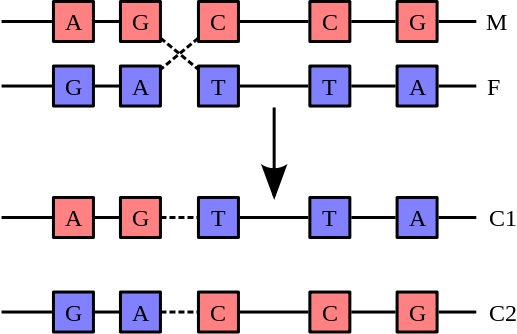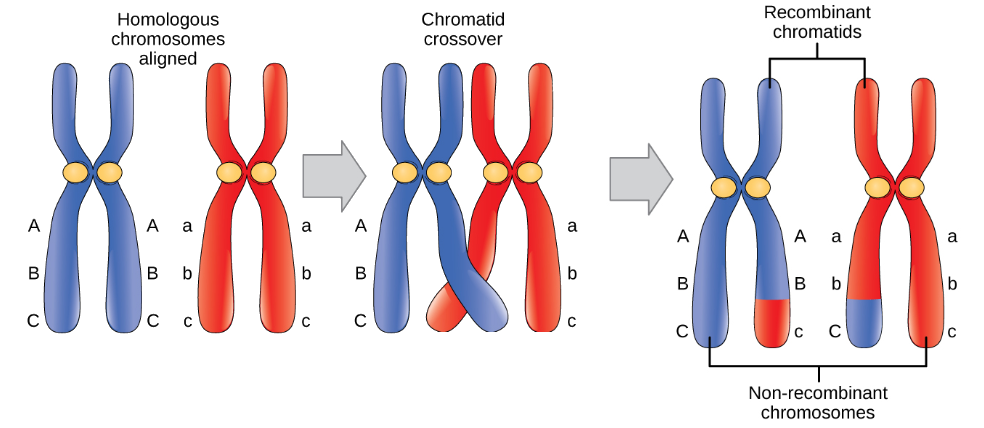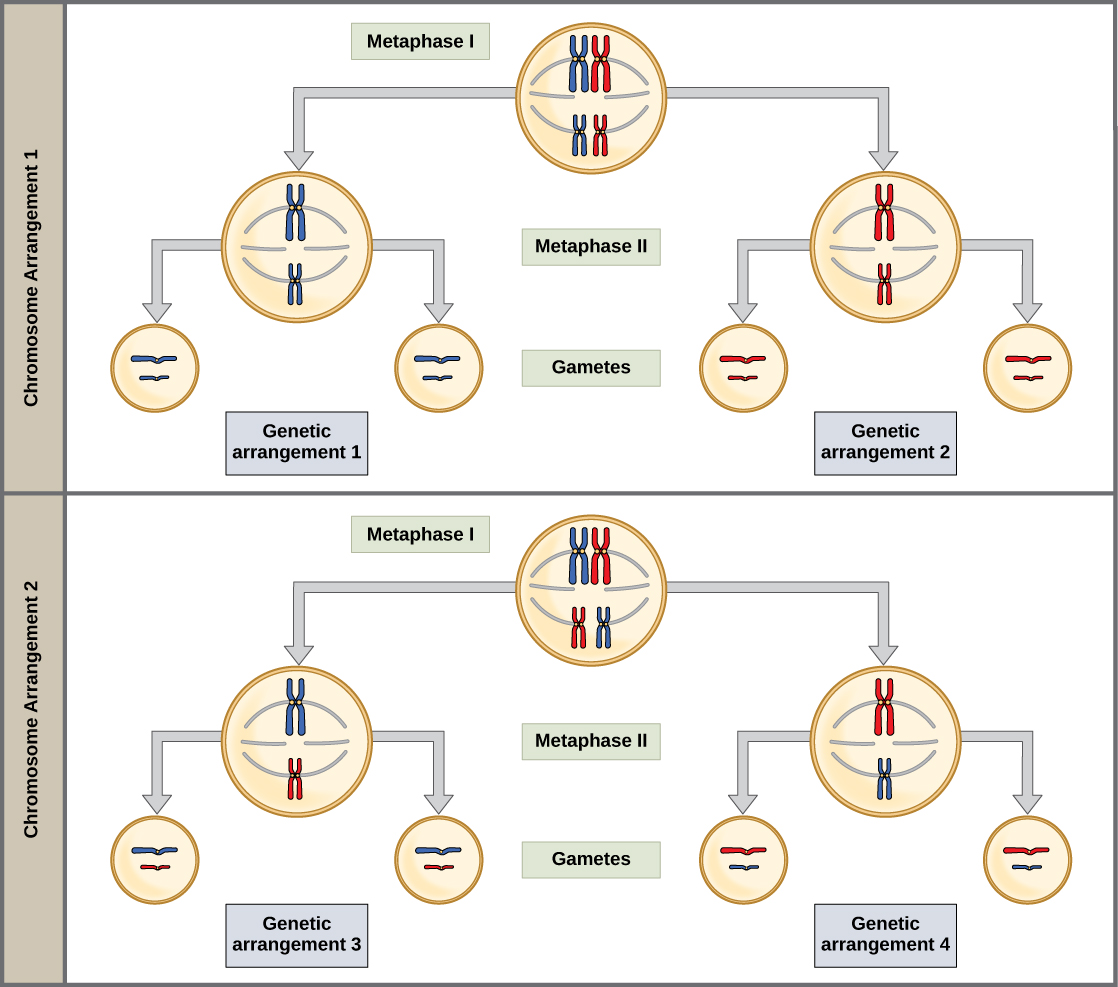How Does Meiosis Affect The Genetic Makeup Of An Organism
seven.6: Genetic Variation
- Page ID
- 16758
Genetic variation. It is this variation that is the essence of evolution. Without genetic differences amid individuals, "survival of the fittest" would not be probable. Either all survive, or all perish.

Genetic Variation
Sexual reproduction results in space possibilities of genetic variation. In other words, sexual reproduction results in offspring that are genetically unique. They differ from both parents and also from each other. This occurs for a number of reasons.
- When homologous chromosomes form pairs during prophase I of meiosis I, crossing-over tin occur. Crossing-over is the exchange of genetic cloth between homologous chromosomes. Information technology results in new combinations of genes on each chromosome.
- When cells carve up during meiosis, homologous chromosomes are randomly distributed to daughter cells, and unlike chromosomes segregate independently of each other. This called is chosen independent assortment. Information technology results in gametes that have unique combinations of chromosomes.
- In sexual reproduction, two gametes unite to produce an offspring. Simply which two of the millions of possible gametes volition it be? This is likely to be a matter of chance. It is obviously some other source of genetic variation in offspring. This is known as random fertilization.
All of these mechanisms working together result in an amazing amount of potential variation. Each human being couple, for example, has the potential to produce more than 64 trillion genetically unique children. No wonder we are all different!
Crossing-Over
Crossing-over occurs during prophase I, and it is the substitution of genetic material between not-sister chromatids of homologous chromosomes. Remember during prophase I, homologous chromosomes line up in pairs, factor-for-cistron down their unabridged length, forming a configuration with iv chromatids, known every bit a tetrad. At this point, the chromatids are very close to each other and some material from two chromatids switch chromosomes, that is, the material breaks off and reattaches at the same position on the homologous chromosome (Effigy \(\PageIndex{2}\)). This commutation of genetic material tin can happen many times within the same pair of homologous chromosomes, creating unique combinations of genes. This procedure is also known every bit recombination.

During prophase I, chromosomes condense and get visible inside the nucleus. As the nuclear envelope begins to break down, homologous chromosomes motion closer together. The synaptonemal complex, a lattice of proteins between the homologous chromosomes, forms at specific locations, spreading to cover the entire length of the chromosomes. The tight pairing of the homologous chromosomes is called synapsis. In synapsis, the genes on the chromatids of the homologous chromosomes are aligned with each other. The synaptonemal complex also supports the exchange of chromosomal segments between non-sister homologous chromatids in a process chosen crossing over. The crossover events are the beginning source of genetic variation produced by meiosis. A single crossover consequence betwixt homologous non-sister chromatids leads to an exchange of DNA betwixt chromosomes. Post-obit crossover, the synaptonemal complex breaks downwardly and the cohesin connection between homologous pairs is also removed. At the stop of prophase I, the pairs are held together but at the chiasmata; they are chosen tetrads because the four sister chromatids of each pair of homologous chromosomes are now visible.

Independent Array and Random Fertilization
During metaphase I, the tetrads move to the metaphase plate with kinetochores facing reverse poles. The homologous pairs orient themselves randomly at the equator. This event is the second mechanism that introduces variation into the gametes or spores. In each prison cell that undergoes meiosis, the arrangement of the tetrads is different. The number of variations is dependent on the number of chromosomes making up a set. There are two possibilities for orientation at the metaphase plate. The possible number of alignments, therefore, equals 2n, where north is the number of chromosomes per gear up. Given these 2 mechanisms, it is highly unlikely that any 2 haploid cells resulting from meiosis volition accept the aforementioned genetic composition.

In humans, there are over 8 1000000 configurations in which the chromosomes tin line upwards during metaphase I of meiosis. Information technology is the specific process of meiosis, resulting in iv unique haploid cells, that results in these many combinations. This independent assortment, in which the chromosome inherited from either the father or mother can sort into any gamete, produces the potential for tremendous genetic variation. Together with random fertilization, more possibilities for genetic variation exist between any two people than the number of individuals live today. Sexual reproduction is the random fertilization of a gamete from the female using a gamete from the male. A sperm cell, with over 8 meg chromosome combinations, fertilizes an egg cell, which also has over viii million chromosome combinations. That is over 64 trillion unique combinations, not counting the unique combinations produced by crossing-over.
Review
- What is crossing-over and when does it occur?
- Depict how crossing-over, independent array, and random fertilization atomic number 82 to genetic variation.
- How many combinations of chromosomes are possible from sexual reproduction in humans?
- Create a diagram to show how crossing-over occurs and how it creates new cistron combinations on each chromosome.
Explore More
How Does Meiosis Affect The Genetic Makeup Of An Organism,
Source: https://bio.libretexts.org/Bookshelves/Human_Biology/Book:_Human_Biology_%28Wakim_and_Grewal%29/07:_Cell_Reproduction/7.6:_Genetic_Variation
Posted by: brownworseente.blogspot.com


0 Response to "How Does Meiosis Affect The Genetic Makeup Of An Organism"
Post a Comment